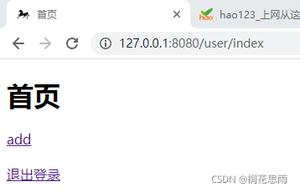带有示例的Python Set update()方法
设定update()方法
update()方法用于通过添加另一个集合(set2)的更多元素来更新此集合(set1),用该集合(set1)调用该方法,并且可以将另一个集合(set2)作为参数提供,用另一个集合(set2)的元素,如果此集合(set1)中存在任何元素,则不会添加该元素。
语法:
set1.update(set2)
Parameter(s):
set2 –它代表另一个要在set1中添加其元素的集合。
返回值:
此方法的返回类型为<class'NoneType'>,它不返回任何内容。
范例1:
# 带有示例的Python Set update()方法# 宣布布景
cars_1 = {"Porsche", "Audi", "Lexus"}
cars_2 = {"Porsche", "Mazda", "Lincoln"}
# 在update()调用之前打印集合
print("Printing the sets before update() call...")
print("cars_1: ", cars_1)
print("cars_2: ", cars_2)
# 通过添加来更新集合(cars_1)
# cars_2元素的元素
cars_1.update(cars_2)
# 在update()调用之后打印集合
print("Printing the sets after update() call...")
print("cars_1: ", cars_1)
print("cars_2: ", cars_2)
输出结果
Printing the sets before update() call...cars_1: {'Porsche', 'Lexus', 'Audi'}
cars_2: {'Porsche', 'Mazda', 'Lincoln'}
Printing the sets after update() call...
cars_1: {'Porsche', 'Audi', 'Mazda', 'Lincoln', 'Lexus'}
cars_2: {'Porsche', 'Mazda', 'Lincoln'}
范例2:
# 带有示例的Python Set update()方法# 宣布布景
x = {"ABC", "PQR", "XYZ"}
y = {"ABC", "PQR", "XYZ"}
z = {"DEF", "MNO", "ABC"}
# 在update()调用之前打印设置
print("Before calling update()...")
print("x:", x)
print("y:", y)
print("z:", z)
# 使用其他集合的元素更新集合
x.update(y)
y.update(z)
z.update(x)
# 在update()调用之后打印集
print("After calling update()...")
print("x:", x)
print("y:", y)
print("z:", z)
输出结果
Before calling update()...x: {'XYZ', 'ABC', 'PQR'}
y: {'XYZ', 'ABC', 'PQR'}
z: {'MNO', 'ABC', 'DEF'}
After calling update()...
x: {'ABC', 'PQR', 'XYZ'}
y: {'ABC', 'PQR', 'XYZ', 'MNO', 'DEF'}
z: {'ABC', 'PQR', 'XYZ', 'MNO', 'DEF'}
以上是 带有示例的Python Set update()方法 的全部内容, 来源链接: utcz.com/z/343140.html







